Plant lamps: varieties and tips for choosing
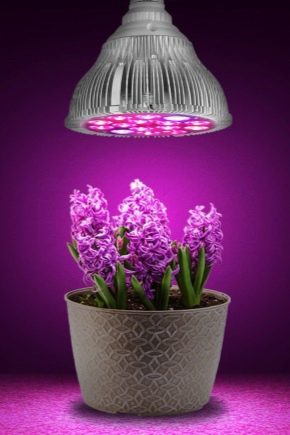
Today, man has invented a lot of additional devices that will be useful in the course of growing various crops in low light. The category of these devices should include phytolamps, presented on the market in a wide variety of types, thanks to which gardeners and gardeners have the opportunity to cultivate various plants and create an optimally suitable environment for them with a minimum of effort and cost.

What it is?
For growing crops at home and for breeding plants in winter in greenhouses, the optimal level of lighting is of great importance, since otherwise all seedlings will simply die. In this situation ordinary incandescent lamps used to illuminate an apartment are not suitable as additional illumination.
During this period, gardeners and amateur gardeners will need special lighting devices for plants that are able to provide crops with a sufficient amount of light, which will guarantee good yields and the health of indoor ornamental crops.


Similar devices take into account the basic need of plants for illumination during the day at least 14 hours... That is why the devices have the optimal number of photons in their radiation, which provides illumination of the full spectrum of solar radiation.
Not so long ago, the list of such devices consisted of conventional incandescent and fluorescent lamps. The former turned out to be completely useless in practice. The second option for plant growth turned out to be effective, since its spectral composition of luminescence is quite similar to that of the sun, due to which luminescent lighting devices in some cases are called fluorescent lamps.
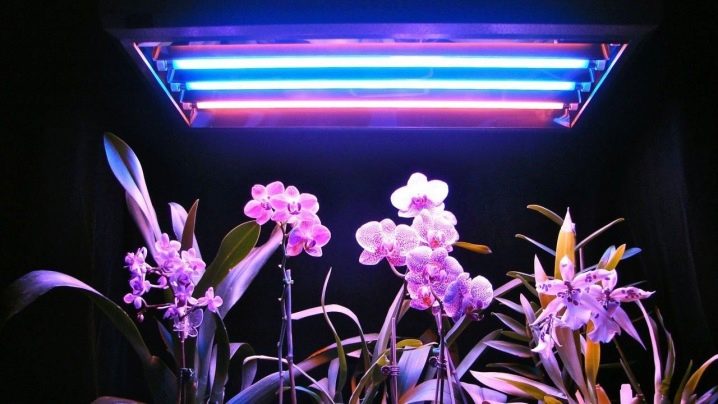
Today, the range of such useful devices has significantly expanded, on sale you can find products with various configurations, however, all positions on the market belong to one group - phytolamps.
The main advantage of such lighting devices is the method of generating photons in a narrow color range, which, in contrast to the wide one, is emitted by most of the lamps and special-purpose lamps. This has a positive effect on the photosynthesis of crops or indoor flowers and plants.

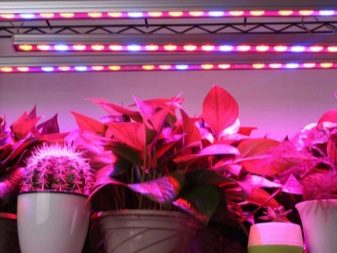


As practice shows, the blue spectrum is aimed at stimulating the growth and development of roots, and the red one is responsible for the flowering process and the ripening of fruits, if the crops are capable of producing a crop.
The configuration of the devices excludes any harm to green cells, so the phytolamp is absolutely not dangerous for plants and fruits that are affected by ultraviolet and infrared radiation. Most of the devices for plant illumination have a combined blue and red glow, so that the devices can be attributed to the universal group. However, there are products on sale that will emit only one color, which is needed in one or another phase of the development of cultures.
The color temperature of devices is measured in Kelvin. As a rule, the manufacturer indicates the power of his products on the packaging and in the instructions.
There is a certain classification of devices:
- 2700K - a phyto-lamp with a similar power emits "warm" light, which is in the red part of the spectrum;
- 4100K - "neutral white" glow, which is closer to the green part of the spectrum;
- 6400K - "cold white" light, it belongs to the blue region of the spectrum;
- 8000-25000K - ultraviolet light.

Advantages and disadvantages
Like any device, phytolamps for plants have their own strengths and weaknesses.
The positive features include such characteristics.
- As a rule, using specialized equipment for greenhouses or greenhouses, you can significantly save on energy consumption. Based on the experience of operating the devices in large agricultural buildings, the savings in comparison with the use of conventional lighting are about 80%.
- The second main advantage of such devices is the efficiency, thanks to which plants receive a certain frequency range that is vital for photosynthesis.
- Since the operating temperature of the lamps is very low, the devices have a high degree of fire safety. In addition, even in case of accidental contact, the devices will not harm a person and will not cause burns to the skin.
Thanks to the peculiarities of the light emanating from the lamps, lighting devices will be useful even when growing plants in basements.

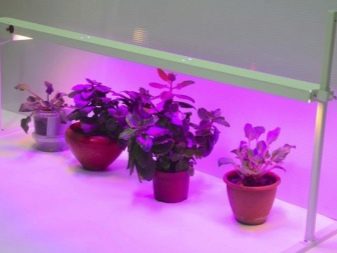
- Lamps do not require additional retrofitting for indoor use. In order for the devices to function, the lamp can be screwed into a standard base and connected over the entire area of the room.
- Due to the minimal heating when growing plants using phytolamps, it will be easier to maintain optimal temperature and humidity inside closed systems and premises.
- During operation, the radiation intensity can be adjusted. This capability is achieved by installing a variable resistance near the switch.
- The devices can create the correct UV flux on crops, which is very convenient in rooms where several varieties of plants grow in different stages of development.
All lighting products are environmentally friendly, so there is no danger to the environment and the air during their operation.
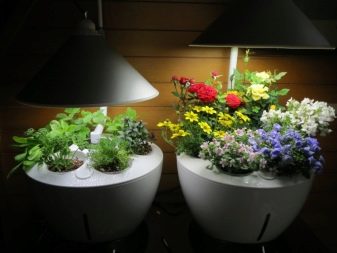

However, some types of devices still have certain disadvantages.
- Incandescent lamps cannot provide crops with a blue and red spectrum, in addition, they get quite hot, which negatively affects crops. This option of additional lighting would be more correct to use in conjunction with luminescent devices, since they give a blue and violet spectrum of radiation during operation.
- Energy saving gas lamps for plants require special accessories for use in the form of ballasts, which in some cases can be quite inconvenient.
- Aquarium lamps show themselves well during operation, however, they stand out for their high cost, therefore, for a large room, their acquisition is unprofitable.


Varieties
For modern gardeners and gardeners, manufacturers of specialized lighting equipment for the agrosphere offer a large selection of effective products. However, the following types are especially popular.
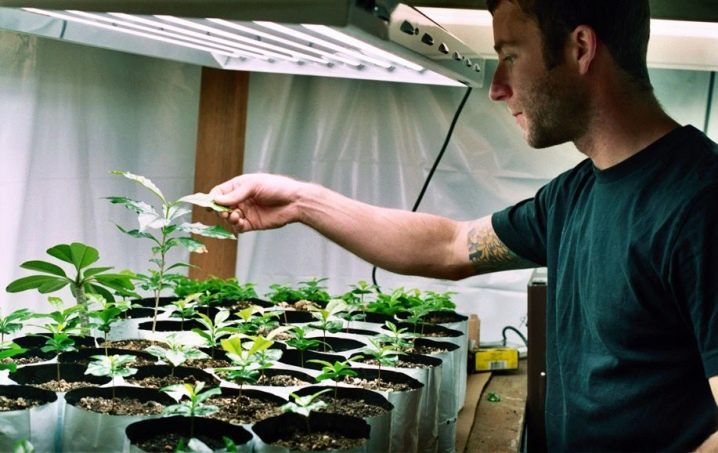
Sodium
This type of backlighting stands out for its long service life, in addition, HPS lamps create a powerful and stable stream of light. Sodium lamps give off an orange-yellow glow that is beneficial to crops and also non-irritating to the eyes. The latter characteristic makes it possible to exploit them for domestic plants, for example, when growing seedlings on a windowsill.
In greenhouses or basements, where there is no lighting at all, such lamps must be used in conjunction with fluorescent lamps.


The color temperature of this backlight is up to 2200K with a color rendering index of about 22 units. For indoor flowers, you should choose devices with a power of up to 100 watts. One lamp can illuminate an area up to 2 meters. For greenhouses and conservatories, it is worth using illumination from 400 to 600 W.
Sodium light is essential for plants in the early and late stages of development. Thanks to devices with a similar spectrum, you can increase the yield of vegetables and fruits, normalize flowering.
In northern regions, it is recommended to combine such illumination with an ultraviolet lamp.
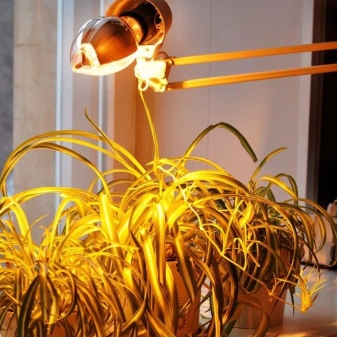

HPS lamps have a service life of 20 thousand hours. A feature of sodium devices is the ability to work and ignite at low temperatures.
However, sodium phytolamps for backlighting have some disadvantages. First of all, they can attract insects, which in most cases will harm developing plants. In addition, instrument control devices will be expensive. During the operation of these types of backlights, special care should be taken, and also avoid contact with water on the flasks.


Induction
This type of backlighting is similar in principle to fluorescent lamps, but its design differs significantly. The difference is due to the absence of electrodes inside, due to which the service life of the devices significantly increases, which is about 60,000 hours.
Before purchasing this option it is worth considering that over time, the brightness of such lamps will gradually decrease... The devices are convenient for their minimal heating, in light of which it becomes possible to place them in the immediate vicinity of growing houses or in a greenhouse of crops.
Induction lamps do not deteriorate from voltage surges in the electrical network, in addition, the lamps do not create flicker that is unpleasant for the human eye.


A positive feature of the emission spectrum of induction lamps is the similarity of light with the sun, due to which the lamps can be used as a full-fledged and independent illumination at different stages of plant development.
Among the disadvantages of induction lighting, their high cost should be noted when comparing products with other types of devices.
Plasma
The main characteristic of such lamps is the use of sulfur in their device, which is not dangerous for plants and people, in light of which plasma options are suitable for installation at home in order to provide plants with light in the off-season and in winter. Such devices almost do not emit ultraviolet light, in the total amount it is noted no more than one percent.
Such illumination has a wide range of applications not only as a home version of a light source for plants, therefore, plasma lamps can be found in landscape design, as well as as a backlight for hydroponic plants in private or public premises.

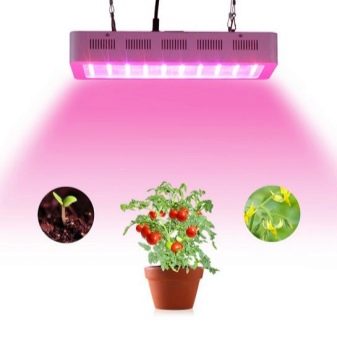
In greenhouses where plasma lamps are used, there is no need to wear special glasses for a normal view, lamps do not distort the true color of plants... At the same time, the devices are able to cope with the task of maintaining the optimal level of illumination over large areas, while using the minimum amount of electricity.
Among the disadvantages of illumination, it is worth highlighting their high cost, however, when carrying out accurate and competent calculations, the purchase of plasma lamps for large rooms with plants will be justified in light of their effectiveness.

Models and their characteristics
Among the available assortment of domestic and foreign phytolamps, it is worth highlighting the most popular brands.

Philips "Green Power"
It belongs to the category of high pressure sodium devices, therefore the products are recommended for all crop development cycles.The lamps give off a good proportion of red and orange radiation, in addition, the glow also shows the presence of blue light, which is needed for crops during the growing season.
The device is manufactured in Belgium and is a device with a transparent bulb with a tube placed inside and a built-in antenna, which is necessary for smooth and productive operation. The maximum operating temperature of the flask is 450 degrees.
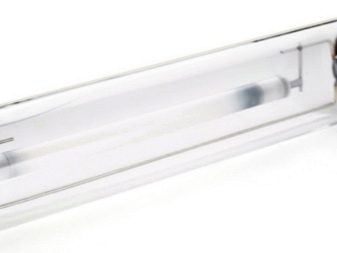

Bicolor
Domestic backlight device, which is a LED lamp with high light dispersion power. This device can be used for supplementary lighting of indoor and greenhouse orchids, growing cacti and citrus crops, as well as for installation in grow boxes and as a light source for hydroponics. Due to their simple design and ease of installation, lamps are in demand for placement in greenhouses.
The device is adjustable in height, due to which you can control the level and intensity of the light supply during the day. The lamp has a resource of 50,000 hours.


LED lamp "Black Sun Edition"
Universal phytolamp, which is recommended for use in greenhouses and greenhouses with plants during the growing season, in the phase of flowering and fruiting. The lamp is small in size, the power of one device is 3W.
The devices are in demand due to the presence in the design of a fireproof housing and patented optical lenses that can distribute light at 90 degrees. The product has two switches.
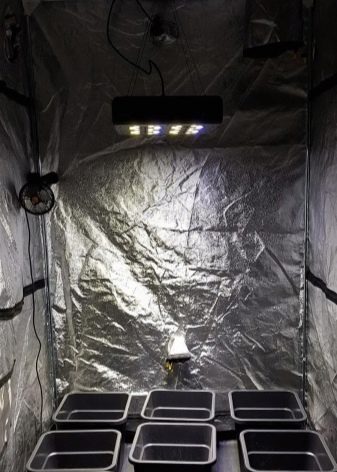

Selection Tips
In order to find a functional and reliable device to support the development of indoor and greenhouse crops, you need to take into account certain nuances.
- The selection of a phytolamp should start with calculating the area from which the device will work. It is also worth deciding on the frequency of lighting. A clear understanding of the requirements for the device will greatly facilitate its selection. As a rule, manufacturers indicate on their products information about product capacity and recommended operating area.
- Before buying, it is also worth deciding at what distance the device will be placed relative to the plants. The best option would be to purchase phytolamps with the ability to adjust their location and height.
- Before purchasing lighting devices, it is also worthwhile to sort the existing crops based on the growing stage.
- For small spaces, such as, for example, a window sill, you can choose models with an average power of the radiated flux. As practice shows, indoor flowers will have enough fluorescent lamps with a glow temperature of about 6500 K. For greenhouses and greenhouses in winter, productive and large lamps of a universal spectrum will be needed.
- To equip a room with lighting, it is worth giving preference to one type of lighting fixture in order to create the most comfortable conditions for the growth of crops.
It is important to select a variety with a high color rendering index within 865 units.


How to use?
The key to successful lighting of crops with phytolamps will be their competent placement. Therefore, in this matter, one should take into account the characteristics of the device, which will help to calculate the required number of lamps for a given area.
The illumination level will be equal to the result of dividing the luminous flux from the device by the square meters of the room with crops.
Almost all manufacturers indicate on the product packaging the recommended area for their device.

As for the basic rules for using lamps, a novice gardener can adhere to the following recommendations:
- lighting should have an orientation similar to that of the sun, that is, shine from top to bottom;
- the most correct removal of cultures from phytolamps will be 30 centimeters;
- the optimal power of the device for illuminating one square meter will be 70 W;
- in winter, the operating time of the devices should be increased by at least 4 hours;
- if you plan to use lighting for seedlings, then in the first few days you should equip with continuous infrared lighting for young seedlings.

Reviews
Among the available responses about the varieties of phytolamps for plants, it is worth noting mainly positive reviews, especially when breeding home seedlings. As for greenhouses and greenhouses, sodium lighting devices are especially popular in these premises, which help to revive even fallen crops in the shortest possible time.
Among the features of phytolamps for plants, the ability to independently create illumination for plants in pots using diodes also stands out.

See below for more details.













The comment was sent successfully.